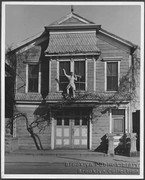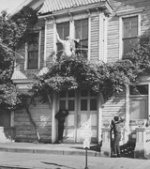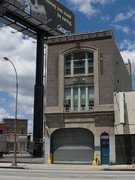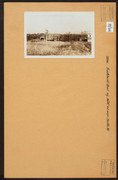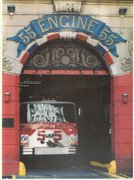You are using an out of date browser. It may not display this or other websites correctly.
You should upgrade or use an alternative browser.
You should upgrade or use an alternative browser.
My younger Buff years
- Thread starter nfd2004
- Start date
M
mmattyphoto
Guest
In regards to E48's old quarters it partially collapsed on the morning of a FDNY medal day not sure of the year.
mmattyphoto said:In regards to E48's old quarters it partially collapsed on the morning of a FDNY medal day not sure of the year.
"Matty", I think I caught the first job at the old 48s/Salvage 3's firehouse. I think the time I caught it, it was in the evening and at that time, it did NOT collapse. In my years of Buffing the jobs, I really have no idea of how many hundreds of fires I actually saw. I can tell you it sure was a lot, going back to the late 60s or so. I think the old firehouse job I caught was maybe in the late 70s or early 80s after the War Years. But this fire I won't forget. It's not everyday that you see lines being stretched into a firehouse. Caught another job that was on the Exposure 2 side of 45/58s quarters on East Tremont Ave. Lines were stretched into that firehouse also, and I believe that fire also went to a second alarm. (48s/Salvage 3s job was also a second alarm when I caught that one).
After Salvage 3 left, went to 3 All hands in 48's old quarters. This was before the 2nd alarm which destroyed the building. When Salvage was closed, I don't think anything was removed. There were beds, lockers, hose, coats and boots still in the building and obvious signs of squatters.
Came across these the other day. (FD347; has a few old pictures taken from the Brooklyn CO you might like to check out).
http://www.flickr.com/photos/timothywildey/collections/72157621922592332/
"Those were the Days my friends"
http://www.flickr.com/photos/timothywildey/collections/72157621922592332/
"Those were the Days my friends"
Last edited:
M
mmattyphoto
Guest
NFD2004, it collapsed sometime after a couple of major fires in the Building. It was my home away from home until 1977 when they moved down the block. I missed the fires but was there when the rear of the building collapsed.
mmattyphoto said:NFD2004, it collapsed sometime after a couple of major fires in the Building. It was my home away from home until 1977 when they moved down the block. I missed the fires but was there when the rear of the building collapsed.
MMatty, I guess you worked there (Salvage 3) during those years. I remember seeing the rig going down Webster Ave. It certainly was a time to be a buff too. But I really don't remember when they moved "down the block". Where did they relocate to ???
M
mmattyphoto
Guest
I was the buff and Aux. FF there for many years. they moved down the block to Webster ave and 187 st. Not long after they moved in we had 1977 Blackout that night was quite wild.
As the War Years were starting to slow down, along came The Blizzard of '78. Basically the Entire northeast closed down for three days. Of course I wasn't down the Bronx or Bed Sty buffing. I went into work for a night shift and spent the next 96 straight hours at the firehouse before I could get home. Of course my wife wasn't too happy when I called her and said I couldn't go home AGAIN. Nine months later the Norwich, Ct Fire Dept had a baby boom.
The FDNY was still battling a lot of jobs. With all that snow, narrow streets, the high winds and drifts, plus the fires I can only guess what it was like. If you were there on the job, or even as a buff, I'm sure there's a few of us out there (I for one), that would like to hear your story.
The FDNY was still battling a lot of jobs. With all that snow, narrow streets, the high winds and drifts, plus the fires I can only guess what it was like. If you were there on the job, or even as a buff, I'm sure there's a few of us out there (I for one), that would like to hear your story.
- Joined
- Jun 27, 2007
- Messages
- 3,730
I am originally from Boston and I remember the great blizzard of 78. We had a major snowstorm on the previous
friday which was followed by a 5-alarm fire at the Navy Yard. The next Monday was the mother of all storms. The city was officially closed down for a week, no driving was allowed! Between the two storms we had almost 30 inches of snow on the ground. They had to call in the National Gaurd, I remember TV shots of USAF C-130's and 141's bringing in snow removal equipment. My house was at the intersection of 3 streets ala Times Square. The Gaurd made a snow mountain in front of my house, the top was level with the second floor! Buffing was out of the question, many members worked 5 straight days! Stay safe everyone
friday which was followed by a 5-alarm fire at the Navy Yard. The next Monday was the mother of all storms. The city was officially closed down for a week, no driving was allowed! Between the two storms we had almost 30 inches of snow on the ground. They had to call in the National Gaurd, I remember TV shots of USAF C-130's and 141's bringing in snow removal equipment. My house was at the intersection of 3 streets ala Times Square. The Gaurd made a snow mountain in front of my house, the top was level with the second floor! Buffing was out of the question, many members worked 5 straight days! Stay safe everyone
Thanks for your story "grumpy". I remember how hard Boston had gotten hit (5 days shut down vs 3 days in Ct). I can only guess what it must have been like for the FDNY. A small snowstorm can be a nightmare for New York City. What was it like in that Blizzard.
In Connecticut cars were abandoned on I-95 blocking all lanes. The snow was up over their rooftops. I had a friend who's back yard abutted the I-95 highway. It was the first time that he told his kids it was okay to go play on I-95. That I-95 became a playground for the kids in the neighborhood for a couple of days. Until the numerous cars were removed and the highway reopened.
That's just one story from the Blizzard of '78. It was still a busy time for the FDNY with fires. I would guess they held everybody over and manned a lot of reserve rigs. I know sometimes we would have to shovel ourselves before we got to the building entrance. I just wonder how those FDNY guys did it with so much snow and going through some of those narrow streets with double parked cars etc.
I guess one of the qualifications to be able to tell any stories is of course; "Old enough to remember". Well there's a few, like myself, G-man, JohnnyD, and now I guess you "Grumpy". Thanks "Grumpy", you told a good story. How about G-man and JohnnyD. Lets hear it for those guys. You want to hear their stories don't you. And maybe a few other Seniors out there can join in too. Especially if you were on the job. Maybe you can give us a clue of what it was like out there.
In Connecticut cars were abandoned on I-95 blocking all lanes. The snow was up over their rooftops. I had a friend who's back yard abutted the I-95 highway. It was the first time that he told his kids it was okay to go play on I-95. That I-95 became a playground for the kids in the neighborhood for a couple of days. Until the numerous cars were removed and the highway reopened.
That's just one story from the Blizzard of '78. It was still a busy time for the FDNY with fires. I would guess they held everybody over and manned a lot of reserve rigs. I know sometimes we would have to shovel ourselves before we got to the building entrance. I just wonder how those FDNY guys did it with so much snow and going through some of those narrow streets with double parked cars etc.
I guess one of the qualifications to be able to tell any stories is of course; "Old enough to remember". Well there's a few, like myself, G-man, JohnnyD, and now I guess you "Grumpy". Thanks "Grumpy", you told a good story. How about G-man and JohnnyD. Lets hear it for those guys. You want to hear their stories don't you. And maybe a few other Seniors out there can join in too. Especially if you were on the job. Maybe you can give us a clue of what it was like out there.
I was listening to some of the old FDNY radio traffic on Hartford Fire Department radio ( http://hfdradio.com/FDNY.htm ) which is a great site. One of the runs I remember was a multiple in Coney Island which turned out to be a dispatcher's 4th alarm. Rescue 2 was assigned - on the 3rd alarm. There was no Rescue 5 (SI) yet. I know Rescue 2 was very busy, but it does seem to be very conservative to wait until the 3rd would be transmitted to start a Rescue for a multiple alarm structure fire. This was a 2nd on arrival and the chief requested Rescue 2 on the 2nd because there were so many occupants being removed.
The 8th division in SI did not respond to Brooklyn back then. Since the 12th Division was unavailable, the covering deputy came from either the 10th or 11th Division, a very, very long run. It does not make any sense that the 8th Division never left SI back then. The bridge was up. What was the logic?
On 10-75's in many parts of the city, there were no 4th engines, no Rescues, no Squads. And no FAST trucks yet. I believe the field comms went on all hands - doubtful fires. I think you had 3 or 4 engines, 2 trucks, 2 BCs and 1 deputy with the field comm (if available) for all hands, another 3 engines and a truck on the 2nd. The 3rd added 3 more engines, another truck and a BC for communications coordinator. (I might have missed a unit or two.) But a 3rd alarm in some parts of the city had maybe 9 or 10 engines, 4 trucks, a Rescue (if available), 3 BCs, a Deputy and a field comm unit. That seems to be equivalent to a 2nd alarm assignment today. It is hard to compare.
I remember being told by a chief that in that part of Brooklyn (Coney Island), all hands - doubtful (7-5 signal) transmissions automatically were upgraded to 2nd alarms because it took so long to to get multiple alarm units to respond in. Was that unique to Coney Island? It would seem other outlying areas (Far Rockaway, City Island) would be similar.
There are also examples of units using the 10-30 (working fire) radio code. This was another thing I do not understand. Did it ever really work - trying to have the first due units differentiate between a 10-30 fire (2 & 2) or a 10-75 fire (3 & 2 or 4 & 2)? Many times, the engine used a 10-30 and the 1st due truck used the 10-75 (or vice versa). Why wasn't the 10-30 code eliminated years sooner?
The 8th division in SI did not respond to Brooklyn back then. Since the 12th Division was unavailable, the covering deputy came from either the 10th or 11th Division, a very, very long run. It does not make any sense that the 8th Division never left SI back then. The bridge was up. What was the logic?
On 10-75's in many parts of the city, there were no 4th engines, no Rescues, no Squads. And no FAST trucks yet. I believe the field comms went on all hands - doubtful fires. I think you had 3 or 4 engines, 2 trucks, 2 BCs and 1 deputy with the field comm (if available) for all hands, another 3 engines and a truck on the 2nd. The 3rd added 3 more engines, another truck and a BC for communications coordinator. (I might have missed a unit or two.) But a 3rd alarm in some parts of the city had maybe 9 or 10 engines, 4 trucks, a Rescue (if available), 3 BCs, a Deputy and a field comm unit. That seems to be equivalent to a 2nd alarm assignment today. It is hard to compare.
I remember being told by a chief that in that part of Brooklyn (Coney Island), all hands - doubtful (7-5 signal) transmissions automatically were upgraded to 2nd alarms because it took so long to to get multiple alarm units to respond in. Was that unique to Coney Island? It would seem other outlying areas (Far Rockaway, City Island) would be similar.
There are also examples of units using the 10-30 (working fire) radio code. This was another thing I do not understand. Did it ever really work - trying to have the first due units differentiate between a 10-30 fire (2 & 2) or a 10-75 fire (3 & 2 or 4 & 2)? Many times, the engine used a 10-30 and the 1st due truck used the 10-75 (or vice versa). Why wasn't the 10-30 code eliminated years sooner?
mack said:There are also examples of units using the 10-30 (working fire) radio code. This was another thing I do not understand. Did it ever really work - trying to have the first due units differentiate between a 10-30 fire (2 & 2) or a 10-75 fire (3 & 2 or 4 & 2)? Many times, the engine used a 10-30 and the 1st due truck used the 10-75 (or vice versa). Why wasn't the 10-30 code eliminated years sooner?
Mack, some very interesting points that you have made. I also remember when there was NO Rescue 5. And I would guess that those Brooklyn outfits really didn't want any S.I. companies coming into Their Turf.
I do also remember the 10-30 signal. Using the 10-30 instead of using a 10-75 saved an extra engine company, somrthing that was at a premium in those days. Three or Four 10-30s going on at the same time saved three or four engines for other work. I can remember going to 10-30s and seeing a mattress being removed from the apts. Or maybe food on the stove that extended a little. As ******* described earlier, sometimes an engine would do 2 or 3 floors of fire themselves. I'm sure as you can relate to, a mattress fire was nothing for the War Years Firefighters. I remember seeing 60/17 operating in the South Bronx for a 5 brick vacant fully involved with no exposures.
Mack, it is possible that that fire occurred during the time that there was no 8th division. I seem to remember that there was a time when S.I. only had a Monday to Friday Administrative Deputy who did not respond to fires. I don't remember when the 8th was put into service.
Bill, before the 10-75 signal was established the 10-30 signified a working fire. After the establishment of the 10-75 code the 10-30 became a request for '2 & 2' ...
Hope this helps ...
Bill, before the 10-75 signal was established the 10-30 signified a working fire. After the establishment of the 10-75 code the 10-30 became a request for '2 & 2' ...
Hope this helps ...

